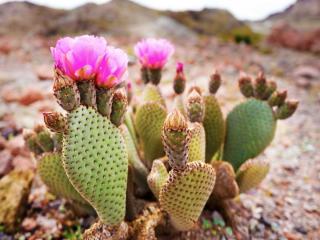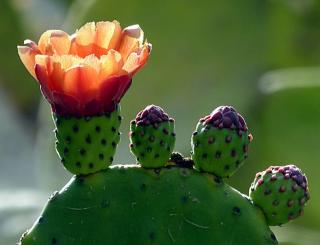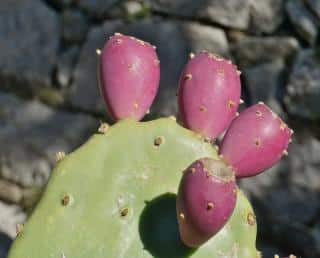

Barbary fig, or Opuntia ficus-indica, is the cactus that bears prickly pears.
Barbary fig key facts
Name – Opuntia ficus‑indica
Family – Cactaceae
Type – perennial cactus
Height – 15 feet (5 m) and more
Soil – light, well-draining, any pH
Hardiness – not hardy (minimum 50°F or 10 °C)
Flowering: spring, summer – Foliage: evergreen – Exposure: full sun
Barbary fig is a perennial cactus that grows as large as a regular tree. Its blue-green stems are formed by pads (the flat portions that look like ping-pong paddles). The blooming for this cactus starts in spring and continues throughout the entire summer. Edible fleshy fruits follow suit: the barbary figs.
Opuntia ficus‑indica won’t grow in just any climate. Indeed, it isn’t hardy at all, to the point that it needs temperatures higher than 50°F (10°C). As a consequence, set it up in full sun so that it can get all the light and heat it needs to thrive.

Growing a barbary fig tree in pots isn’t impossible. However, it grows very large when it matures and will still have lots of spikes and pricks: repotting and moving the pot will get increasingly difficult.
Since it doesn’t fear drought, you won’t need to water your barbary fig. If it is set up in a pot, you’ll have to:
 water only when the surface of the substrate has dried up;
water only when the surface of the substrate has dried up;You won’t need to prune your barbary fig.
You can multiply your plant either through seed or through stem cuttings in spring or summer.
Barbary fig is a resistant perennial. It generally doesn’t fall sick. Nonetheless, there is one situation that is sure to kill it: root rot due to insufficient drainage in the soil. Regarding pests, you’ll have to stay on the lookout for scale insects, they’ll quickly overrun your plant.
The shape, size and growing requirements of the Barbary fig tree make it an excellent choice for dry gardens. Compose a wonderful exotic landscape together with:
Common names – barbary fig, Mickey Mouse cactus, prickly pear, tree cactus

There are also quite a lot of hybrids, and a relative often sold as houseplants is Opuntia vulgaris.
→ Read also: health benefits of Barbary fig
The barbary fig cactus has spikes on both leaves and fruits. Once lodged in your skin, they’re hard to remove. It’s important to wear gloves and to be careful when you handle the plant.